In early October, Lotus, Lia, and Minnie were each bred to their respective dates for the season. Now with breeding season (hopefully) over we’ve been waiting, for approximately six weeks, to confirm pregnancies.
There are a number of methods of determining whether or not bred does are pregnant. If a doe fails to return to heat at the time of her next cycle, there’s a good chance that she may be pregnant, but it’s not a guarantee.
Some breeders, especially those with larger herds, will use a simple blood test to diagnose pregnancy, however, as our herd is small we prefer to use ultrasound to confirm pregnancy in our does.
Although a blood test will help distinguish pregnant, from non-pregnant does, it tells you nothing about how many fetuses a doe may be carrying.
We don’t pen-breed, so we have accurate breeding dates, but if you do pen breed, confirming pregnancy via ultrasound can help to better approximate breeding dates, and help prevent surprises in the barn, or unexpected kiddings outside in frigid weather, risking kid survival.
Most importantly, goat nutrition can be optimized during the late stages of pregnancy, when the nutritional demands of the fetuses are at their highest. This not only helps to prevent having an under-conditioned doe at the time of freshening, but may also help to prevent overfeeding those does that are only carrying single fetuses. Too great a plane of nutrition for does only carrying singles may lead to an over-sized kid at birth, resulting in dystocia (birthing difficulty).
So, once our does are past 45 days pregnant we schedule their pregnancy ultrasounds. Today, Royalia and Minnie should be 49 days pregnant, and Lotus would be 48 days. Lily, however, is only potentially 28 days pregnant, so we didn’t ultrasound her today. We’ll ultrasound Lily in mid-December.
Lotus was bred to Darby, and as this is Darby’s first breeding season we were very interested to see if this pairing was indeed a success.
You can see Darby trying all of his best pick up lines in this video (G rated, I promise).
After she was bred, we didn’t see Lotus come back into heat, so we were optimistic. So this morning Lotus was first up for ultrasound, and we confirmed that she is pregnant again.
This year one fetus was very clearly visible, and there was a hint at the possibility of a second, but the ultrasound transducer couldn’t be positioned to clearly visualize another fetus. The one we could see though was hamming it up for the camera, and practically waving at us with all four hooves wiggling about, as you may be able to see in the video clip below. We’ll likely re-ultrasound Lotus when Lily has her ultrasound in a couple of weeks, just to double check her status.
If Lotus is shown to only be carrying a single fetus at that time, we’ll have to be especially careful with her diet in late pregnancy. We already had enough fun pulling this big-headed buckling from her earlier this year, and he was one of three kids!
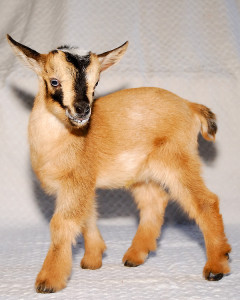
When there are multiple kids, the kids tend to be smaller. This guy didn’t get that memo and needed a little help
Next up was Lia, who was bred to Zedoary. We know that Zedoary has already sired offspring, as he was bred to a few does before we transported him down to the farm from Oregon. As soon as we started to scan Lia there was no question she was pregnant, with at least twins.
It can be difficult to assess whether does are carrying more than two during an ultrasound though, as things are moving around a lot, and fetal positioning can make counting a little tricky.
If you’re not used to looking at ultrasounds, it can be a little difficult to tell what you’re looking at, but I promised last year that I’d try my best to get some video this year. Please forgive that this Farm Woman was multitasking at the time, and this hand-held camera doesn’t have the best resolution. However, you can see teeny goat babies bouncing about (and they’re feisty, even at this age). In this video I have included a couple of captions to help point out heads, and a placentome*. If you look very closely, you can actually make out hooves occasionally too! (In YouTube you can set the image quality to 720P which may help improve the resolution).
Like Lia, Minnie was bred to Zedoary as well.
Note though that Minnie is missing from the video above…oh Minnie. We her love her to pieces, but as herd queen she can be prone to more than just a little drama on occasion. I was in charge of goat wrangling this morning, in addition to trying to man the hand-held camera (hence the slightly skewed orientation of the image from time to time). Unfortunately, I needed both hands to hold Minnie up in a standing position so we could ultrasound her. She decided we had absolutely no business looking around back there, and insisted on laying flat down on the stanchion. With a little persistence we got the job done though, but as my hands were full I couldn’t shoot any video of her. Maybe next year I should try wearing a helmet camera to keep my hands free! Minnie looked a lot like Lia though as she’s at the same stage of pregnancy, and Minnie was confirmed to be carrying 2+ fetuses. If today was any indication, training Minnie as a first freshener to be milked should be an immense amount of fun next spring! Some desensitization training might be in order before then I think…perhaps when she’s too heavily pregnant to run away…
So, with all the girls confirmed pregnant this morning, now we wait some more! From breeding to kidding is approximately five months for goats. Lia and Minnie are due to kid March 1st, and Lotus is due March 2nd, 2014. If Lily is pregnant, she’ll be due in late March, but we’ll know more about her in a couple of weeks. Needless to say, I think next March will be a little busier here than last year, but I have to admit, I already miss having kids running around. Really, if you’ve never seen five day-old dwarf goats racing around in circles around a coffee table, you should find this video to be at least a little entertaining!
I’m so looking forward to seeing our new kid crop next spring!
—————-
*For more on ruminant placentation, see Placentation in Ruminants in Pathophysiology of the Reproductive System. 2006. Colorado State University.

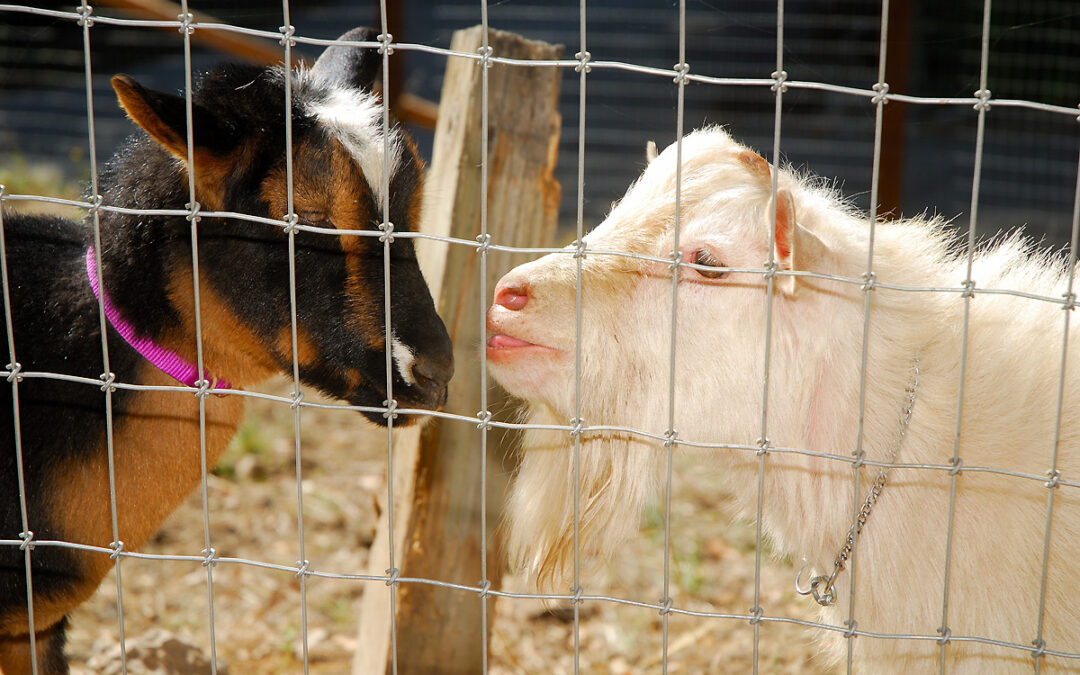

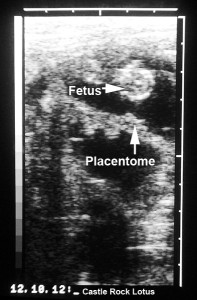
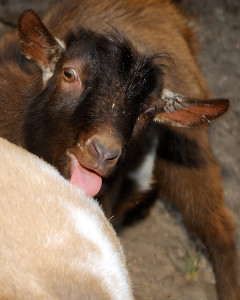

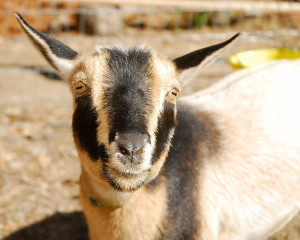
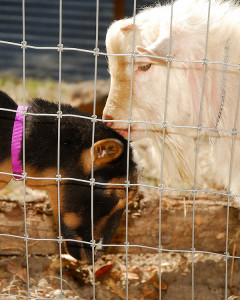
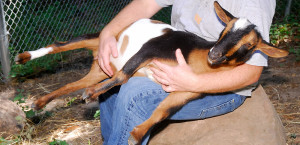







Good job! Something to celebrate, for sure! Makes me wonder,…how many goats are an ideal number for your space? Each one seems to have it’s own personality and I remember the darling video of the babies….so cute. And Happy Holidays!
For does I’d probably not keep more than 8-10 here. We’re still looking for a flatter farm property though, so hopefully before the herd gets too big we can move. We won’t keep all the kids from these breedings though, as much as I’d like to 😉
Oh Clare this is great news and you will be busy come spring….I can’t wait to see more little goats in 5 months 🙂
Actually, we’re down to about three and half months now! I know that time is going to fly by. I do have a few winter projects I need to get done before these girls kid though, as I’ll have my hands full by March! 😛
SO exciting!! I have a doe that I hope is bred…do you do your own ultrasounds? If you have the vet do them, can I ask the cost? I’m so curious, and want to get her back with the buck if she’s not preggers, so probably should find out for sure…
I wish! I can’t cost justify doing my own at the moment, so I have a vet come out. If you just have the one doe to scan, I’d suggest taking your doe to the vet, rather than having the vet come to you. For me the field call is more than it costs to scan two does, so if you can put your doe in a crate and drive her to ultrasound you’ll save a lot of money. I think this year it was around $50 per doe scanned (not including the field call), and that’s about on par with what I hear others are paying for US too. I need a much larger herd before I can cost justify my own ultrasound machine for the farm though. They start at around $10k…used…and barns with diva goats in them can be hard on the transducers 😛
That said, if you just want to know pregnant/not pregnant for rebreeding purposes, you might also check the cost of the BioPRYN test (I’ve never used it, so can’t speak to cost for a single doe), although you will have to pay shipping for the sample. Dr. Meyers may be able to give a quote on the blood test though!
Thanks, I’ll look into that!
When you started with the hives, I thought “that’s a lot of work!”. Then you got the goats, and now that you have almost as many of them as bees, I say again “that’s a lot of work!”
Don’t know how you do it. 🙂
Haha, not quite as many goats as bees (although our bee numbers are quite low at the moment). The goats are work, but I love spending time with them, so it’s all worth it 🙂